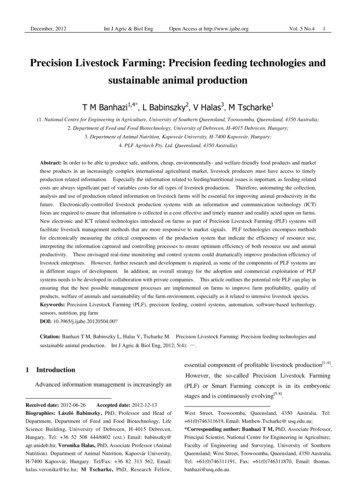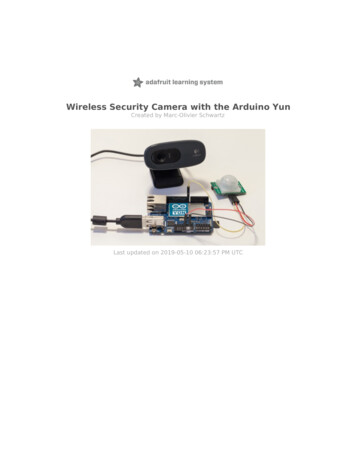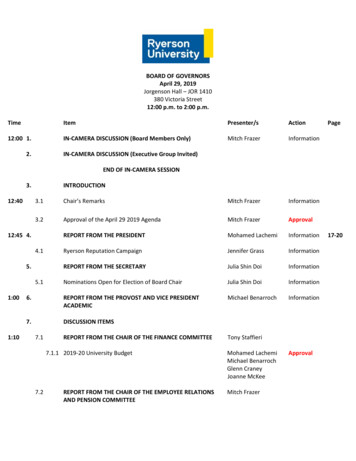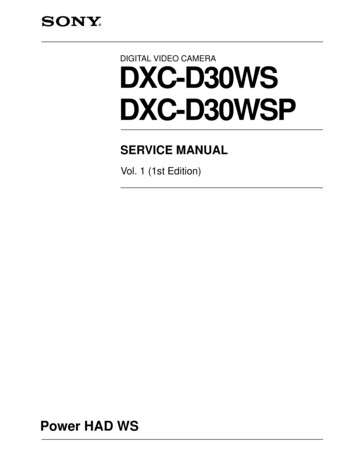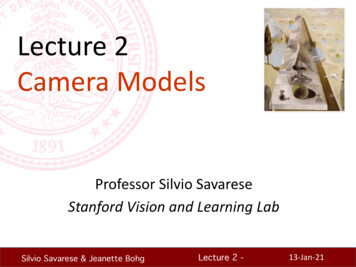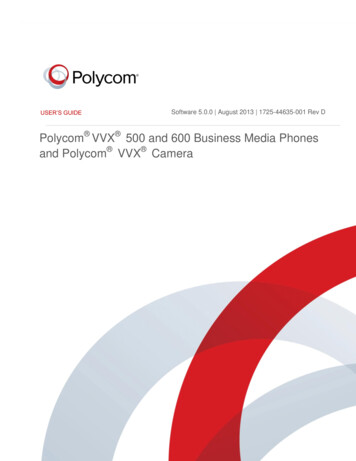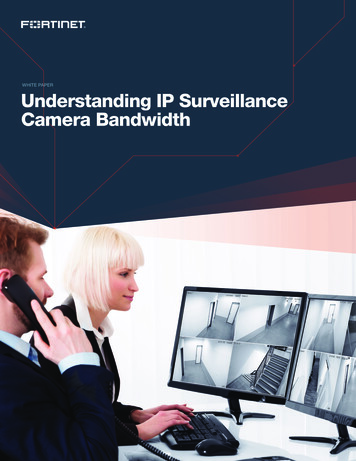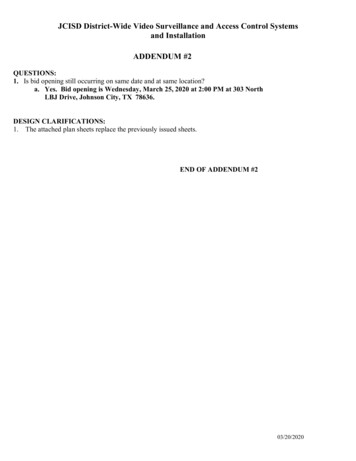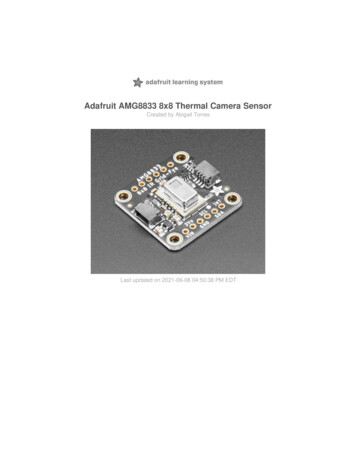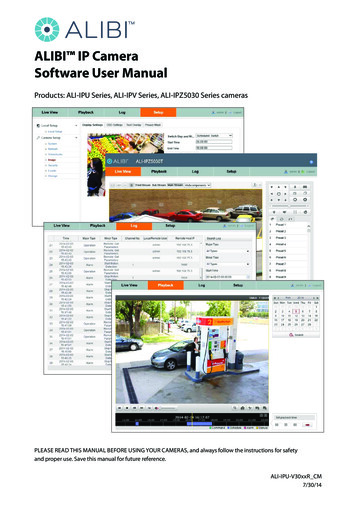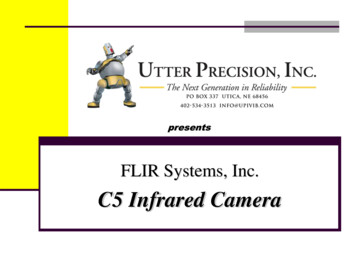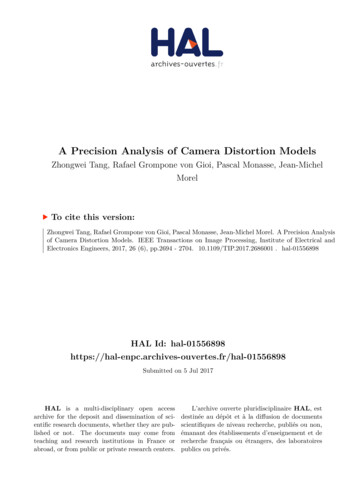
Transcription
A Precision Analysis of Camera Distortion ModelsZhongwei Tang, Rafael Grompone von Gioi, Pascal Monasse, Jean-MichelMorelTo cite this version:Zhongwei Tang, Rafael Grompone von Gioi, Pascal Monasse, Jean-Michel Morel. A Precision Analysisof Camera Distortion Models. IEEE Transactions on Image Processing, Institute of Electrical andElectronics Engineers, 2017, 26 (6), pp.2694 - 2704. 10.1109/TIP.2017.2686001 . hal-01556898 HAL Id: hal-01556898Submitted on 5 Jul 2017HAL is a multi-disciplinary open accessarchive for the deposit and dissemination of scientific research documents, whether they are published or not. The documents may come fromteaching and research institutions in France orabroad, or from public or private research centers.L’archive ouverte pluridisciplinaire HAL, estdestinée au dépôt et à la diffusion de documentsscientifiques de niveau recherche, publiés ou non,émanant des établissements d’enseignement et derecherche français ou étrangers, des laboratoirespublics ou privés.
1A precision analysis of camera distortion modelsZhongwei Tang,1 Rafael Grompone von Gioi,2 Pascal Monasse,1 and Jean-Michel Morel21 LIGM, UMR 8049, École des Ponts, UPE, Champs-sur-Marne, France2 CMLA, ENS-Cachan, Cachan, FranceAbstract—This paper addresses the question of identifyingthe right camera direct or inverse distortion model permittinga high subpixel precision fit to real camera distortion. Fiveclassic camera distortion models are reviewed and their precisioncompared for direct or inverse distortion. By definition, thethree radially symmetric models can only model a distortionradially symmetric around some distortion center. They canbe extended to deal with non-radially symmetric distortionsby adding tangential distortion components, but still may betoo simple for very accurate modeling of real cameras. Thepolynomial and the rational models instead miss a physical oroptical interpretation, but can cope equally with radially and nonradially symmetric distortions. Indeed, they do not require theevaluation of a distortion center. When requiring high precisions,we found that the distortion modeling must also be evaluatedprimarily as a numerical problem. Indeed, all models except thepolynomial involve a non-linear minimization which increases thenumerical risk. The estimation of a polynomial distortion modelleads instead to a linear problem, which is secure and muchfaster. We concluded by extensive numerical experiments that,although high degree polynomials were required to reach a highprecision of 1/100 pixels, such polynomials were easily estimatedand produced a precise distortion modeling without over-fitting.Our conclusion is validated by three independent experimentalsetups: The models were compared first on the lens distortiondatabase of the Lensfun library by their distortion simulationand inversion power; second by fitting real camera distortionsestimated by a non parametric algorithm; and finally by theabsolute correction measurement provided by photographs oftightly stretched strings, warranting a high straightness.Index Terms—distortion measurement, camera calibrationI. I NTRODUCTIONThe pinhole camera model is widely used in computervision applications because of its simplicity and its linearityin terms of projective geometry [14]. But real cameras deviatefrom the ideal pinhole model. The main geometric deviationis a lens geometric distortion [3], possibly complicated by adeviation from planarity of the CCD shape. Thus an accuratecamera distortion correction is the first step towards highprecision 3D metric reconstruction from photographs. With thesteady progress in lens quality and camera resolution, highprecision 3D reconstructions become feasible. But they requirein turn higher camera distortion precisions than those providedby classic methods. The object of this paper is to investigatethe validity of distortion models at the light of precision requirements increased by two or three orders of magnitude. Thisincreased accuracy requires a new methodology for evaluatingdistortion models. Five models are studied and evaluated inthe paper: the radial [3], division [10], FOV [9], polynomial(such as bicubic [15]), and rational [7], [13] models. They relyon several different hypotheses on the underlying distortionmodel. Clearly their precision depends on which model hypothesis is valid. Radially symmetric models are very precisefor radially symmetric distortions. They can be extended totreat non-radially symmetric distortions by adding tangentialcomponents. The polynomial model and the rational modelimpose the fewer constraints on the distortion, to the costof an increased number of model parameters. Thay way theycan cope with radial and non-radial symmetric distortions aswell. Among them the polynomial is the only linear model.Its estimation is a simple matrix inversion. All the othermodels require a somewhat complex non-linear minimization.We shall see that the linearity of the polynomial model reducesits numerical risk and makes its modeling precision closer to1/100 pixels for realistic camera distortions.It could be argued that a correct model should be basedon physical measurements on systems of lenses. Surprisinglyenough, there is little physical background for the distortionmodels in the literature. According to Weng et al. [30],lens distortion can be decomposed into three effects: radialdistortion, decentering distortion and thin prism distortion.Nevertheless, it is only marginally based on a physical background, and it is not clear that the real distortion preciselyfollows this model. In fact, the final distortion is the result ofthe cumulated effects of a complex lens system, of the camerageometry, and of the (not perfectly planar) shape of the imagesensor. One is therefore led to figure out a flexible modelwith enough parameters to simulate any plausible distortion. Inabsence of a physical model, the model classification approachadopted here will be to look for models that actually cope withany realistic distortion, at a given precision.Many works in the computer vision community assume thatthe distortion is radially symmetric around the center of theimage, and the radial, division and FOV models are often usedto simulate and inverse the radially symmetric distortion. Eventhough these models are not exactly (algebraically) invertible,the simulation and correction can be obtained at very highprecision if the order of the model is high enough, as we willshow in Section III. This explains why these models in theliterature are used with the interchangeable roles of distortedpoints and undistorted points. For example, direct distortionmodels are used in global camera calibration [29], [32], [17],[30]. Yet, in most plumb-line methods [3], [9], [1], [2], [25],[23], [22], [6] or some pattern-free methods [26], [31], [10],[19], [28], [7], [21], [4], [16], the very same radial correctionmodels are used without any fuss to inverse the distortion.In practice, the distortion center is unknown and we donot even a priori know if the distortion is radially symmetricaround a certain center. So the radially symmetric models
2with an arbitrarily fixed distortion center (typically, the imagecenter) is not always a good model. The common practiceis to fix the distortion center at some reasonable positionand add tangential distortion components to the model. Allthe global camera calibration methods adopt this strategy byfixing the distortion center at the principal point. An alternativeis to estimate the distortion center that makes the radiallysymmetric models fit optimally to the distortion. For example,Hartley and Kang [12] propose to estimate the distortion centerunder the assumption that the distortion is radially symmetricand monotone. Being more general, the polynomial model andthe rational model are invariant to the distortion center and canbe directly used to model the distortion without estimating anydistortion center.Our aim is to find models which are flexible and easy touse, producing small residual error no matter what reasonabledistortion has been applied. Ideally we would like to test onall possible distortions of any existing camera lens. Sinceexhaustive testing is impossible, we resorted to the lensdatabase of the LensFun library, which is known to contain themost complete freely available lens profiles. All the distortionsprovided by Lensfun are radially symmetric around the imagecenter.The question we raise here only makes sense within fixedaccuracy bounds. This is a first caveat: any evaluation mustbe performed at a given precision. As a matter of fact, foroff-the-shelf cameras, most distortion models perform well ata 1 pixel precision. The question is different when we aimat sub-pixel precisions. These precisions, up to 1/100 pixels,are highly desirable when using cameras for stereovision orphotogrammetric tasks. Indeed, in stereovision a determiningfactor is b/h, the ratio of baseline to average depth. A high ratio improves accuracy of depth determination by triangulation,but makes automatic image matching more difficult because ofthe significant viewangle change. On the contrary, a low ratioeases the point-matching step but requires sub-pixel estimationto avoid a strong quantization of recovered depths. The lattercase is advisable for automatic processing, hence the need forhighly accurate distortion correction.The other caveat is that, although distortion models reflecta model of the optical lens, the real distortion must actuallyinvolve the whole system lens plus CCD. There is no wayto guarantee that a CCD is absolutely flat, or exactly perpendicular to the optical axis. This explains why the cameradistortion modeling remains, after all, an empirical questionwhere no physical argument can be final. The ultimate decisionis numerical.The various distortion models will be carefully compared onlens distortions in the Lensfun library, permitting to quantifythe ideal attainable precision. Then, the same models will becompared on their capacity to fit to real camera distortions(estimated by a non-parametric algorithm [11]). Finally, thedistortion correction accuracy by each model will be evaluatedby using the plumb-line approach, with photographs of tightlystretched strings, warranting a high straightness, and givingabsolute measurements of the correction quality [27]. In short,there will be three different numerical validations of ourconclusions.This paper is organized as follows. Section II reviews fiveclassic distortion models. Their power to simulate and inversedistortions are evaluated in Section III by synthetic experiments. Section IV and V describe the experiments performedon real cameras. Section VI sums up the lessons learned fromthese experiments.II. D ISTORTION AND C ORRECTION MODELSWe denote by (xu , yu ) the coordinates of an undistortedpoint as would be observed by an ideal pinhole camera. Dueto the lens geometric distortion, this point will be observed atcoordinates (xd , yd ). The distortion is modeled by a function fthat transforms undistorted to distorted coordinates,xd fx (xu , yu )yd fy (xu , yu ).(1)A correction model g performs the inverse transformation,xu gx (xd , yd )yu gy (xd , yd ).(2)A particularly interesting case is when the function f or gshows radial symmetry relative to a fixed distortion center(xc , yc ). In that case we obtain a compact formulation usingradial coordinates x̄u xu xc , ȳu yu yc , x̄d xd xcand ȳd yd yc ; then, the distortion can be expressedas thep2 ȳ 2 tox̄transformation of the undistortedradiusr uuupthe distorted radius rd x̄2d ȳd2 .We start by reviewing the most current models. To treatboth directions in a neutral way, we will write the modelsas transforming from coordinates (x1 , y1 ) to (x2 , y2 ). Whena model would be used as a distortion model, (x1 , y1 ) willcorrespond to (xu , yu ) and (x2 , y2 ) to (xd , yd ), and it is theopposite when used as a correction model.The radial model displaces a point along its radial directionoriginating at the distortion center. The new radius r2 is afunction of the original radius r1 ,r2 r1 (k0 k1 r1 k2 r12 · · · ).(3)The parameter k0 represents a scaling and therefore does notintroduce distortion. The scaled image is distorted by k1 , k2 ,. . . If all are positive, we have a pincushion distortion; if allare negative, a barrel distortion. Mustache distortion occursif the signs are not the same1 . Note that the distortion center(xc , yc ) is also a parameter of radial models.The division model is obtained by simply putting the factorterm (k0 k1 r1 k2 r12 · · · ) on the denominator,r1r2 .(4)k0 k1 r1 k2 r12 · · ·In these models, high-order coefficients are needed to modelextreme distortion in fish-eye lenses or other wide anglelens systems. A more sparse representation is obtained byparameterizing the distortion by the field of view (FOV).The only parameter of the FOV model is the field of viewparameter ω:tan(r1 tan(ω)) 2r2 .(5)tan(ω)1 To be exact, it depends on the concavity or convexity (or their absence)of the polynomial on the right hand side of (3) over the extent of the image.2 This formula is slightly different from the original one proposed in [9]because we work in the normalized image domain and we consider ω as halfof the field of view instead of the full field of view.
3lens makerThe Taylor expansion of the FOV model around r1 0 istan2 (ω) 3 2 tan4 (ω) 5r1 r1 · · · .(6)r2 r1 315So the FOV model is a radial model with odd terms aroundr1 0. Note that the order-0 scale coefficient is fixed to be 1and all the other coefficients are coupled to ω. So to modelmore complex distortions, the authors proposed to complete itwith k0 , k1 , k3 , · · · :3r2 tan(r1 tan(ω)) r1 (k0 k1 r1 k3 r13 · · · ).tan(ω)CanonNikonSonyOlympusTamron(7)PentaxIn the polynomial model the distortion is modeled as apolynomial in
case is advisable for automatic processing, hence the need for highly accurate distortion correction. The other caveat is that, although distortion models reflect a model of the optical lens, the real distortion must actually involve the whole system lens plus CCD. There is no way to guarantee that a CCD is absolutely flat, or exactly per-pendicular to the optical axis. This explains why the .
